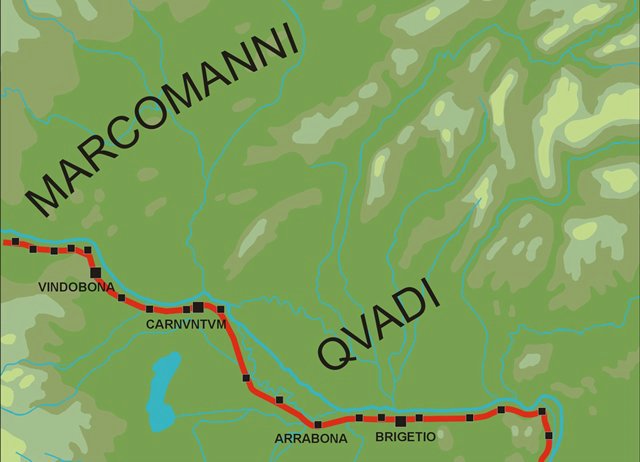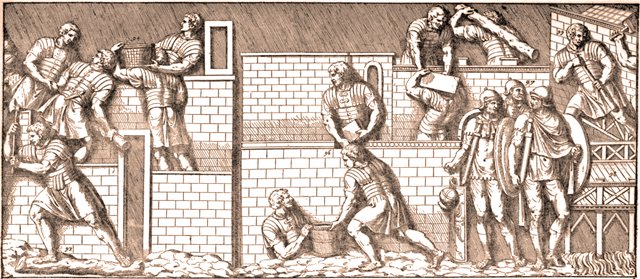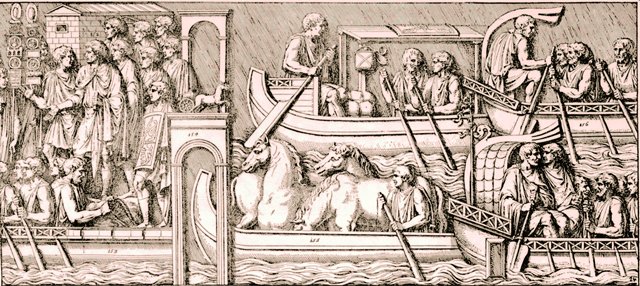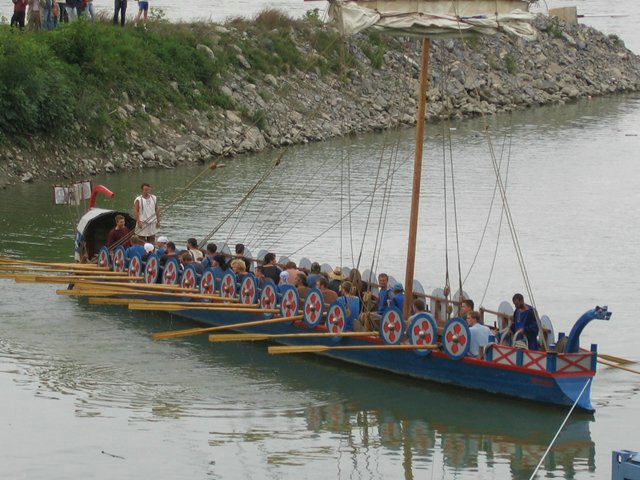|
Since the reign of the
Emperor Augustus, almost the entire Roman army had been placed on
the territories along the boundaries of the provinces, though the
building of permanent forts only began during the reign of the
Emperor Claudius (41-51 A.D.). At the time the legionary fortress
at Carnuntum (today´s Bad Deutsch-Altenburg and Petronell,
Austria) was set up on the important crossroad of long-distance
Amber and Danubian trading routes. Other forts were build on those
strategic points where the Roman auxiliary units were placed, e.g.
in Arrabona (Győr), Brigetio (Komárom/Szőny), Aquincum
(Budapest). However, the systematic construction of the Roman
fortifications along the Pannonian frontier started only during
the reign of the Flavian
Dynasty. The apprehension of Romans of the growing power of the
north transdanubian Germanic tribes at that time was reasonable.
During the reign of the emperor Domitian (81-96 AD) rise the
battles on the middle Danube territory. The Romans were defeated
by the Suebi and their allies Sarmatians, who had been occupying
the territory east of Danube, by the Tisza river, since the 1st
century AD. These wars definitely ended, not before the reign of
the Emperor Nerva (96 – 98 AD) - the successor of Domitian. The
unpleasant experience forced the Romans to elaborate new plans for
better protection of the Pannonian frontier and strengthen its
defence system. More military units were placed along the Danube
and a system of fortifications - limes romanus - was build.

During
the reign of the Emperor Trajan (98-117 AD) – when the Roman
Empire reached its largest extension – other 3 legions were sent
to the frontier. The X. legion (gemina) built
a fortress in Vindobona (Vienna), the I. auxiliary legion (adiutrix)
in Brigetio and the II. auxiliary legion in Aquincum. The
Pannonian army was supplemented also by more auxiliary troops.
Since the reign of the Emperor Hadrian (117-138 AD), when the
number of military units in the province stabilised, the
North-Pannonian frontier became to be the most powerful and well
armed defence system of the Empire. It was guarded by the three
legions, two support troops consisting of 6-7 cavalry, 5 infantry
and 2 mixed formations. Their forts (castellum) were build,
as a chain fortification system protecting the frontier along the
Danube, with the distance of 15-30 kilometres form each other.
There were watch-towers (burgi) between some of these
forts, creating a control and signal system. The
fortification chain was united by a route which was
a part of a long distance road connecting the other
Danubian provinces. Due to marshy region in the area of inland
Danube delta, the limes fortresses and the route system had
to swerve south to the Mosony Danube. The defence of the frontier
and the distribution of supplies and goods was also duty of the
Danube Fleet with number of ports in the area.
Since
then, the North-Pannonian frontier belonged to the strongest and
the best armed defence system of the Empire. The province, that
had played only a secondary role in the beginning, gained the
great importance in the 2nd century AD. The borders of
the province were the closest place to the territory of Italia,
and the Pannonian army played a key role in the defence of the
Empire against the attacks of barbarian tribes during the
Marcomannic wars, which ended the relatively peaceful decades of
the Antonine period.

 
The Roman Army
The armament and equipment of the Roman Soldiers
The role and importance of the Roman Army
Marcomannic wars on the Danube
The period of prosperity and decline
The last attempts and the decline of the Roman authority
|





